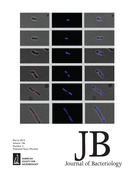- Submit a Protocol
- Receive Our Alerts
- Log in
- /
- Sign up
- My Bio Page
- Edit My Profile
- Change Password
- Log Out
- EN
- EN - English
- CN - 中文
- Protocols
- Articles and Issues
- For Authors
- About
- Become a Reviewer
- EN - English
- CN - 中文
- Home
- Protocols
- Articles and Issues
- For Authors
- About
- Become a Reviewer
In vitro Dynamic Model of a Catheterized Bladder and Biofilm Assay
Published: Vol 5, Iss 2, Jan 20, 2015 DOI: 10.21769/BioProtoc.1381 Views: 13311
Reviewed by: Anonymous reviewer(s)

Protocol Collections
Comprehensive collections of detailed, peer-reviewed protocols focusing on specific topics
Related protocols
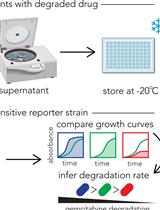
Functional Assay for Measuring Bacterial Degradation of Gemcitabine Chemotherapy
Serkan Sayin and Amir Mitchell
Sep 5, 2023 1723 Views
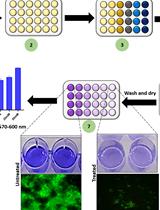
A Guideline for Assessment and Characterization of Bacterial Biofilm Formation in the Presence of Inhibitory Compounds
Bassam A. Elgamoudi and Victoria Korolik
Nov 5, 2023 2968 Views
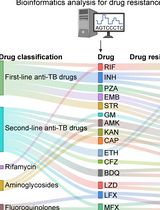
Identification of Mycobacterium tuberculosis and its Drug Resistance by Targeted Nanopore Sequencing Technology
Chen Tang [...] Guangxin Xiang
Feb 5, 2025 1938 Views
Abstract
Biofilm formation on catheters is thought to contribute to persistence of catheter-associated urinary tract infections (CAUTI) which represent the most frequent nosocomial infections. Understanding of factors relevant for CAUTI pathogenesis and evaluation of new therapeutics or interference strategies requires a model system that mirrors the physico-chemical conditions prevailing in a catheterized human bladder. The described in vitro dynamic model of a catheterized bladder enables to emulate many of the characteristics of a catheterized human bladder albeit in the absence of a bladder epithelium. A minor modification compared to the original model system (Stickler, et al., 1999) allows temperature maintenance of the top 10 cm of the catheter, thereby enabling reproducible monitoring of biofilm formation on the internal catheter surface.
Materials and Reagents
- NaCl (Carl Roth, catalog number: 9265.1 )
- 70% ethanol
- dH2O
- NaCl (Carl Roth, catalog number: 9265.1)
- Tryptone (Carl Roth, catalog number: 8952.3 )
- Yeast extract (Carl Roth, catalog number: 2362.2 )
- Agar-agar (Carl Roth, catalog number: 5210.2 )
- Na2SO4 (Carl Roth, catalog number: 8560.1 )
- CaCl2.2H2O (Carl Roth, catalog number: CN93.1 )
- MgCl2.6H2O (Carl Roth, catalog number: 2189.1 )
- NaCl (Carl Roth, catalog number: 9265.1)
- Na3C6H5O7.2H2O (Carl Roth, catalog number: 3580.1 )
- (COONa)2 (Carl Roth, catalog number: 4267.1 )
- KH2PO4 (Carl Roth, catalog number: 3904.1 )
- KCl (Carl Roth, catalog number: 6781.1 )
- NH4Cl (Carl Roth, catalog number: K298.2 )
- Urea (Carl Roth, catalog number: X999.3 )
- Tryptic soya broth/CASO medium (Carl Roth, catalog number: X938.1 )
- Gelatine (Carl Roth, catalog number: 4582.2 )
- NaOH (Carl Roth, catalog number: 6771.1 )
- LB medium (see Recipes)
- LB agar (see Recipes)
- Artificial or human urine (see Recipes)
Equipment
- Peristaltic pump for urine filtration (e.g. Heidolph Instruments GmbH, model: Pump drive 5006 )
- 10 L polycarbonate carboy for urine reservoir (e.g. Thermo Fisher Scientific, Nalgene®, 10 L PC with polypropylene cap with three inlets)
- SARTORIUS P Midi Cap filter cartridge (SARTORIUS, catalog number: 5235307H9 )
- Peristaltic multi-channel pump for urine feed (Watson-Marlow Pumps Group, model: 205U )
- Borosilicate Glass bladder models (Figure 1) (Georg Becker Laboreinrichtungen GmbH & Co KG, www.laborbecker.at)
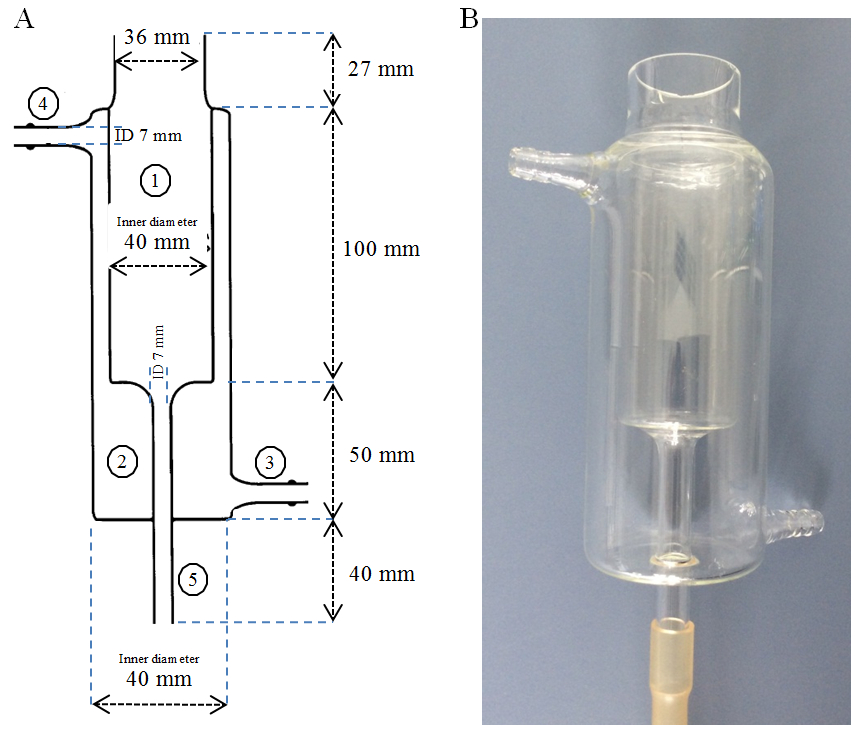
Figure 1. Glass bladder model scheme and dimensions. Schematic representation including length and inner diameter (ID) indications A and custom-made model B. Relevant parts are indicated: Artificial bladder compartment (1), temperature control compartment (2), connection for incoming (3) and outgoing (4) temperature control water circuit, artificial urethra for catheter insertion (5).
- Water bath with connections for external water circle (e.g. LAUDA, model: E10 )
- Tripod or other holders for mounting of glass bladder models (e.g. Bochem Instrumente GmbH, Portable table frame TG, catalog number: TG500 )
- Silicone stopper (35 mm) with 6 mm decentralized hole
- Glass tube (15 cm, 6 mm outer diameter = OD)
Note: We use cut 1 ml glass pipettes (BRAND).
- Silicone tubings: 2 m (ID 3 mm, OD 5 mm)
- Silicone tubings: 1 m (ID 9 mm)
- Silicone tubings: 1 m (ID 5-6 mm)
- Tygon tubings (ID 8 mm) (VWR International, catalog number: 228-1294 )
- Tube Connectors (PP, 3-5mm - 6-10 mm) (Bartelt, catalog number: 37.559 )
- T-connectors (PP) for tubings (ID 3 mm) (Carl Roth, catalog number: E763.1 )
- Urinary Catheter (all silicone Ch14) (BARD, catalog number: 153509 )
- 10 ml syringe
- Drainage bags (e.g. SARSTEDT AG, catalog number: 74.5220.005 )
- Clamps (e.g. VWR International, catalog number: 229-0072 )
- Ultrasonic cleaner (BANDELIN electronic, model: Sonorex RK100H )
- Vortex (e.g. VWR International, catalog number: 444-0206 )
- Recommended (air vents as breathing barrier for urine reservoir flask) (e.g. VWR International, catalog number: 28144-160 )
Procedure
- Preparation (Day 1)
- Overnight cultures (ONC) of test strains in LB medium (1 ml) are grown at 37 °C/180 rpm in an incubator shaker for 16 h.
- Autoclave bladder models, media bottle, filter cartridge, tubings and connectors prepared for the number of models you want to run (either in beakers or in aluminium foil).
- Depending on the time frame of the experiment, artificial urine (~700 ml/day/bladder model) is prepared according to Stickler et al. (1999) and filtered through a 0.45 µm filter cartridge (Sartobran P) into an autoclaved bottle (Figure 2).
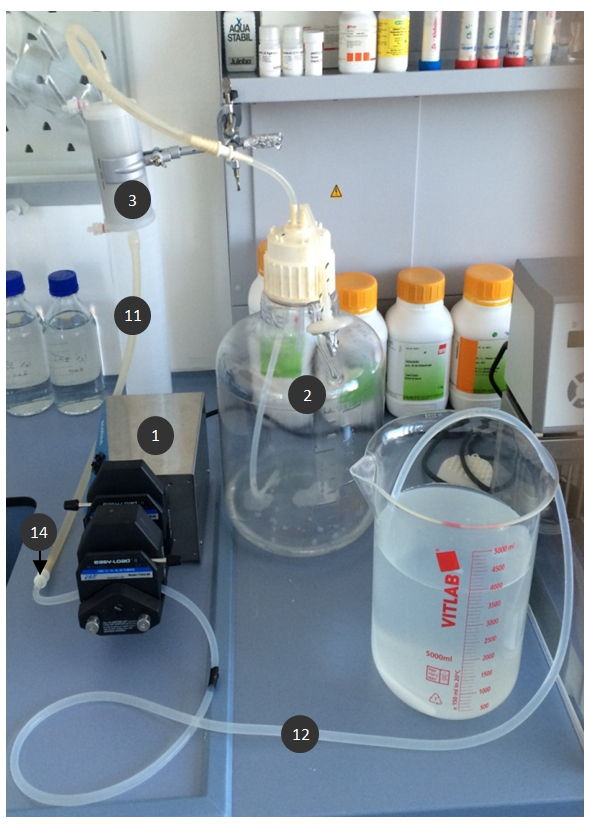
Figure 2. Assembly of filter sterilization for large volumes of artificial urine. The same procedure is applicable for pooled human urine. Relevant visible parts are marked according to equipment list.
- Overnight cultures (ONC) of test strains in LB medium (1 ml) are grown at 37 °C/180 rpm in an incubator shaker for 16 h.
- Inoculation (Day 2)
- Prepare a culture of test strains: 0.5 ml ONC in 20 ml sterile artificial urine incubated for 2-4 h at 37 °C/180 rpm.
- Install the heating water cycle (37 °C) and connect the urine supply tubings. Insert the tubing in the peristaltic pump (Figure 3 and Figure 4; Figure 5 for schematic representation).
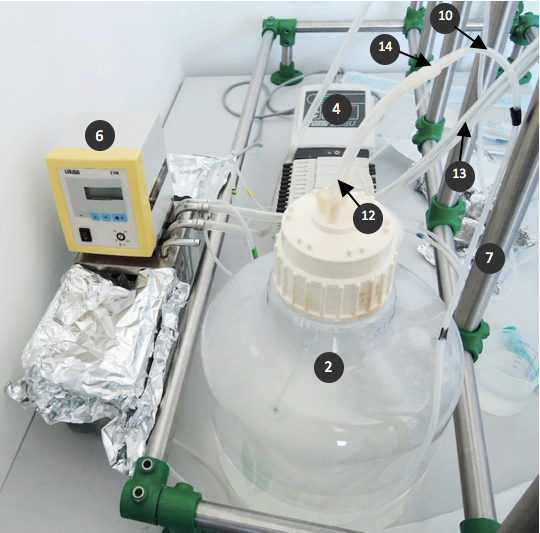
Figure 3. Connection of water cycle and urine supply. Water bath is directly connected to the bladder models (not shown), the urine is pumped from the reservoir using a peristaltic pump (use a channel for each model). Relevant visible parts are marked according to equipment list.
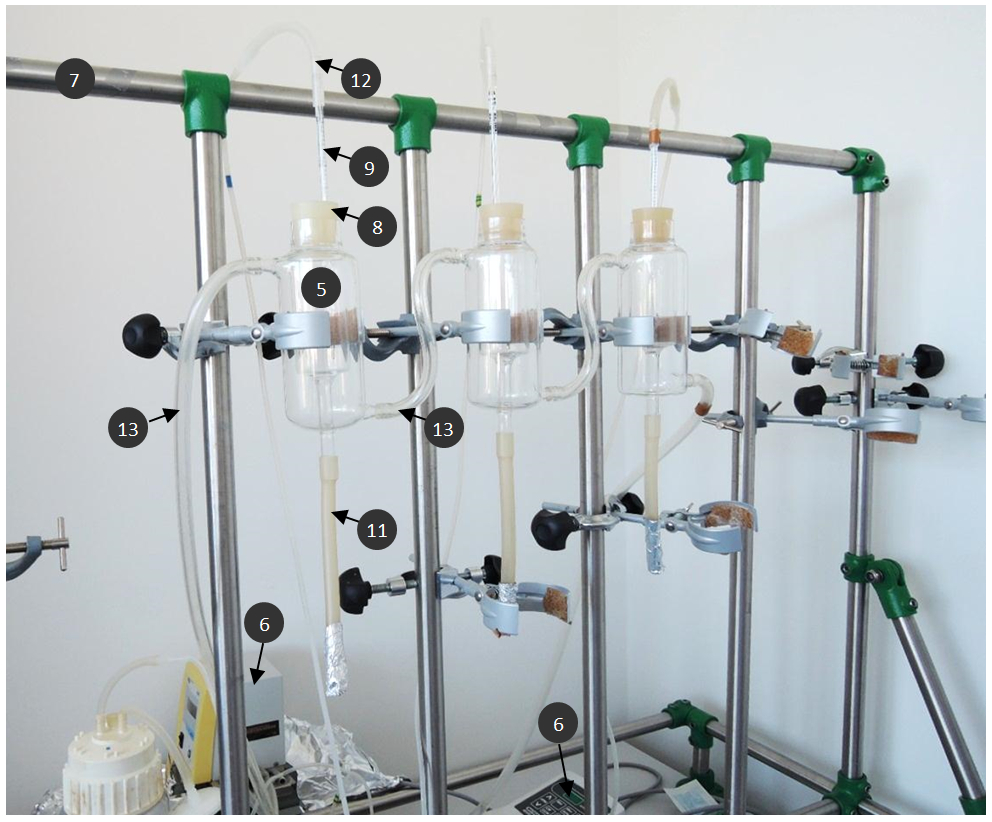
Figure 4. Bladder model system with three bladders after connection of tubings prior to catheter insertion. Relevant visible parts are marked according to equipment list.
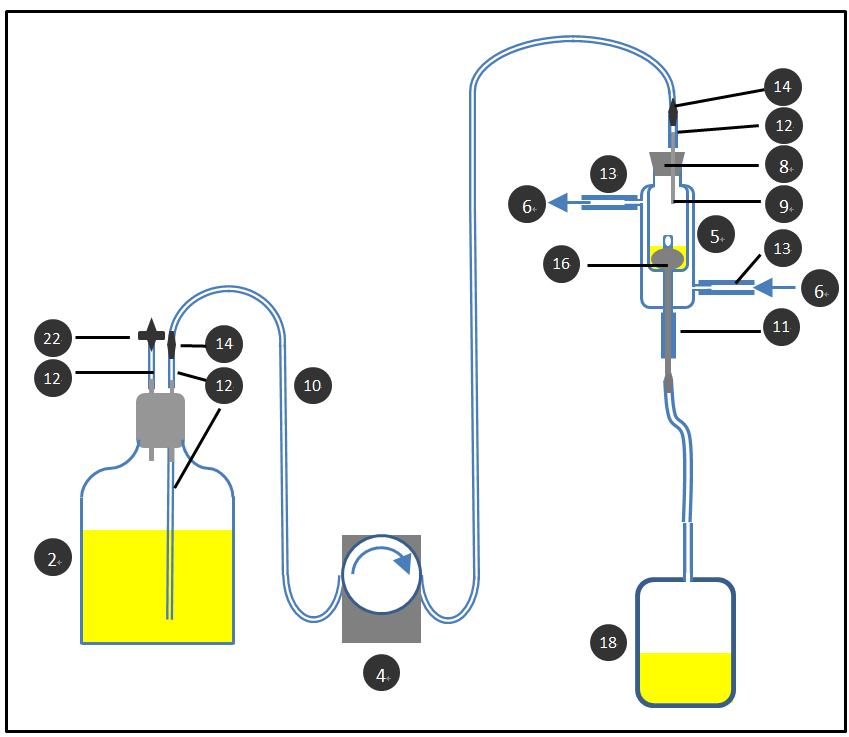
Figure 5. Schematic representation of the closed system necessary for setup of a catheterized bladder model. For simplicity, one bladder without mounting equipment or water bath are shown. Relevant parts are marked according to equipment list.
- Insert a sterile Foley-catheter in each bladder and inflate the retention balloon with 10 ml H2O. Connect each catheter with the drainage bag.
- Fill the urine supply system and the bladders using the peristaltic pump to a level just underneath the eye hole of the catheter (Figure 6; Note: Check that the catheters are tight so that the bladders are not leaking!) Stop the urine flow and clamp of the tubings after the pump.
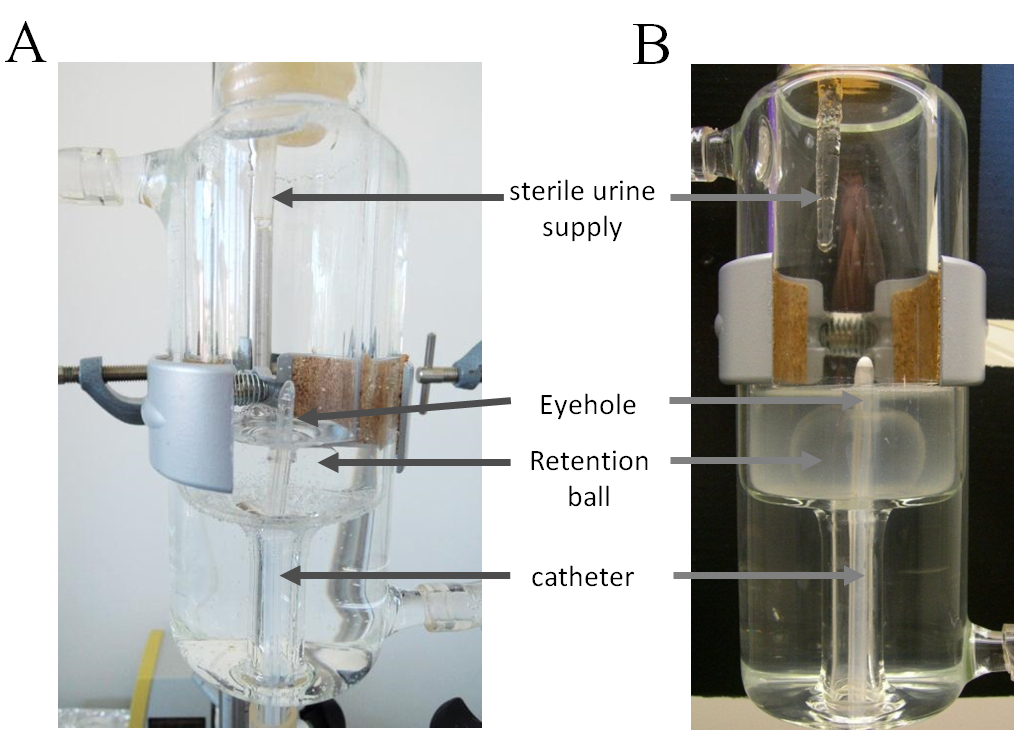
Figure 6. Close up of artificial bladder model after catheter insertion and filling A and after cultivation B. Relevant parts are indicated.
- Measure OD600 of the cultures. Inoculate each model with an appropriate amount of cells for your experiment (depending on the infection phase you are interested the inoculum can range e.g. from 1 x 106 to 1 x 109 cfu). To do so remove the corresponding volume of urine from the models and replace it with the same volume of culture.
- Remove the clamp and start the urine flow 30-60 min after inoculation (~30 ml/h, corresponds to 1.7 rpm using Watson-Marlow 205U using 5 mm silicone tubings).
- Prepare a culture of test strains: 0.5 ml ONC in 20 ml sterile artificial urine incubated for 2-4 h at 37 °C/180 rpm.
- Quantification of colonization
- Stop the urine flow, mix or sample the bladder content and carefully remove it to completion (transfer the bladder content to a 50 ml tube). You can estimate the volume by using a balance (1 g ~ 1 ml).
- After disconnection of the drainage tubing from the catheter, slowly deflate the retention ball. Carefully remove the catheter from the bladder and transfer it to a sterile surface. Cut away the tip of the catheter (including the eyehole) and transfer it to a microcentrifuge tube. Rinse the internal surface of the remaining catheter to remove unattached cells from bladder content with 2 ml of 0.9 % NaCl solution or sterile urine.
- Cut and transfer 1 cm catheter segments to 1,000 µl 0.9% NaCl solution.
- Sonicate the bladder contents and the saline solutions with the catheter pieces for 5 min (room temperature, 35 kHz, one round), then vortex for additional 2 min.
- Dilute suspensions in 0.9% NaCl solution (bladder to 10-6, catheter suspensions to 10-5).
- Plate 50-100 µl of dilutions on LB agar plates (with or without selection).
- Following incubation calculate the colony counts to receive cfu/ml bladder content and cfu/cm catheter. In competition experiments, determine the competitive index (the ratio of harvested CFU of e.g. the mutant strain relative to e.g. the parental strain, divided by their ratio in the inoculum).
- Stop the urine flow, mix or sample the bladder content and carefully remove it to completion (transfer the bladder content to a 50 ml tube). You can estimate the volume by using a balance (1 g ~ 1 ml).
Representative data
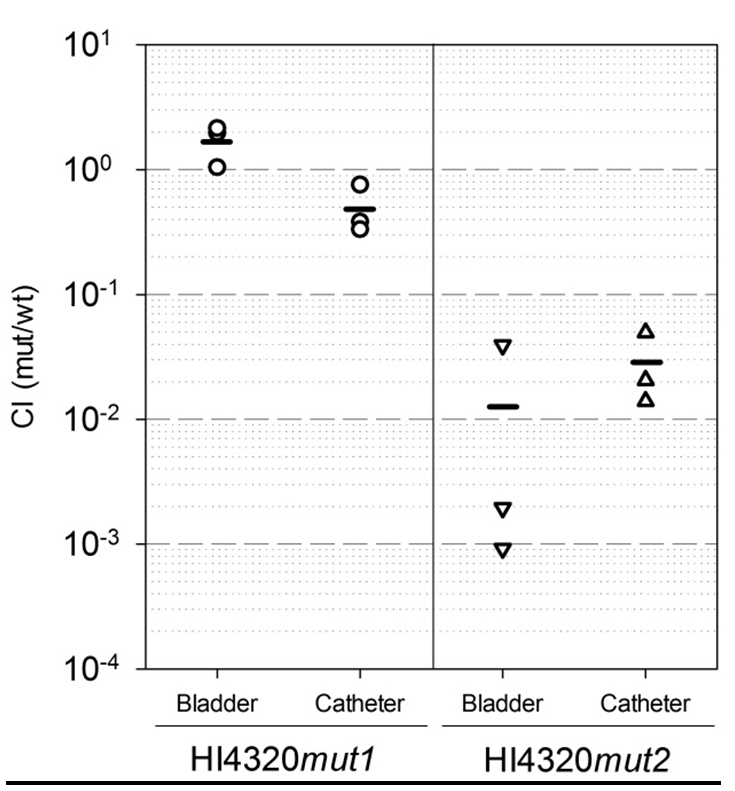
Figure 7. Effect of random mutations on competitive bladder and catheter colonization. Dynamic catheterized bladder models were inoculated with equal amounts of Proteus mirabilis HI4320 wild type and transposon mutant cells HI4320mut1 and HI4320mut2, respectively. Following irrigation with artificial urine for 24 h, population distribution in the residual urine of the artificial bladder and on the internal catheter surface was determined based on CFU. CI values indicate the ratio between the mutant type and the wild type strain in the output (bladder suspension or catheter) divided by the ratio of the two strains in the inoculum. Symbols represent CI values obtained in individual experiments, the line indicates the mean CI value.
Notes
- Due to high variation observed with the in vitro model system due to varying efficiency of biofilm disintegration, experiments need to be performed in triplicate. For comparison of fitness of two strains (e.g. wild type and mutant), competition experiments (e.g. inoculating two strains in the same artificial bladder) are recommended (Reisner et al., 2014 ).
- Statistical Analysis: Independent challenges and co-challenge experiments are routinely analyzed using paired t-test. If a data set does not fulfill necessary criteria for a parametric test, the nonparametric Wilcoxon matched-pair test can be applied.
Recipes
- Luria-Bertani broth (LB) and agar (1 L) (Bertani, 1951)
Mix 10 g Tryptone, 5 g NaCl and 5 g Yeast Extract
Add dH2O to 1 L
For LB agar add agar to a final concentration of 1.5 %
Sterilize by autoclaving and store at room temperature
- Artificial urine (Stickler et al., 1999)
Add the following substances and dissolve in pre-warmed dH2O (max. 40 °C):
Adjust pH by addition of NaOH tablets to 6.1
g/L
Na2SO4
2.30
CaCl2.2H2O
0.65
MgCl2.6H2O
0.65
NaCl
4.60
Na3C6H5O7.2H2O
0.65
(COONa)2
0.02
KH2PO4
2.80
KCl
1.60
NH4Cl
1.00
Urea
25.00
Add gelatine (5 g/L) and stir with heating to dissolve (max 40 °C liquid temperature)
Add autoclaved tryptic soya broth (TSB, 1 g /L) to filtered urine
Acknowledgments
Establishment of the protocol in the lab was funded by the Austrian Science Fund FWF: P21434-B18 (to A.R.). The protocol is adapted and modified from a previous protocol (Stickler et al., 1999).
References
- Bertani, G. (1951). Studies on lysogenesis. I. The mode of phage liberation by lysogenic Escherichia coli. J Bacteriol 62(3): 293-300.
- Stickler, D. J., Morris, N. S. and Winters, C. (1999). Simple physical model to study formation and physiology of biofilms on urethral catheters. Methods Enzymol 310: 494-501.
- Reisner, A., Maierl, M., Jörger, M., Krause, R., Berger, D., Haid, A., Tesic, D. and Zechner, E. L. (2014). Type 1 fimbriae contribute to catheter-associated urinary tract infections caused by Escherichia coli. J Bacteriol 196(5): 931-939.
Article Information
Copyright
© 2015 The Authors; exclusive licensee Bio-protocol LLC.
How to cite
Maierl, M., Jörger, M., Rosker, P. and Reisner, A. (2015). In vitro Dynamic Model of a Catheterized Bladder and Biofilm Assay. Bio-protocol 5(2): e1381. DOI: 10.21769/BioProtoc.1381.
Category
Microbiology > Antimicrobial assay > Antibacterial assay
Microbiology > Microbial biofilm > Biofilm culture
Microbiology > Microbe-host interactions > In vitro model
Do you have any questions about this protocol?
Post your question to gather feedback from the community. We will also invite the authors of this article to respond.
Share
Bluesky
X
Copy link


